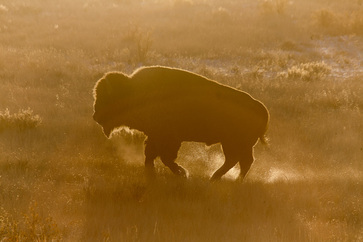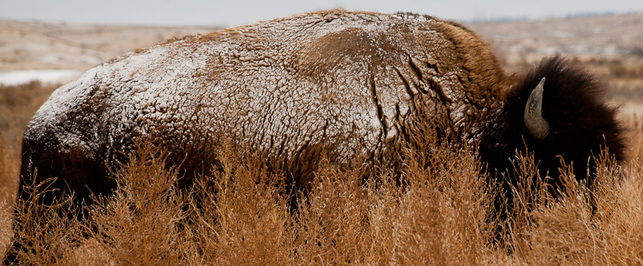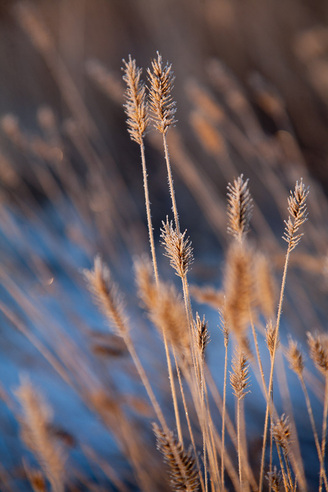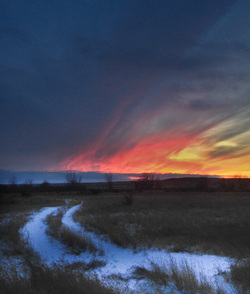The trick of the quiet: winter on the northern prairie
Is it not likely that when the country was new and men were often alone in the fields and the forest they got a sense of bigness outside themselves that has now in some way been lost… Mystery whispered in the grass, played in the branches of trees overhead, was caught up and blown across the American line in clouds of dust at evening on the prairies.
-Letters of Sherwood Anderson
I wondered briefly at the bison’s ability to weather winter out on this unsheltered landscape. But my thoughts mostly focused on the necessities of walking quickly and staying warm. A gentle but persistent wind began blowing from the south and though the air was warming it did not keep up with the windchill. Looking into the wind my eyes occasionally teared, then froze shut at the lashes.
Cresting a hill I caught a flash of movement ahead. A pronghorn leapt from a grass bed and began an easy lope. Suddenly an entire patch of the prairie flinched and leapt to follow. A herd of eight pronghorn stretched behind the leader in a line. They moved with the wind, heading north in a straight arrow. They cruised easily at 30 or 40 mph putting a quick mile between themselves and my silhouette on the horizon. You could have balanced a wine glass on their backs as their legs churned beneath them. Once they were out of sight I followed their tracks back to their beds. The grassy hollows were still warm and the snow had not yet turned to ice. I recorded the sighting in an all-weather notebook and took a GPS location.

Between these sightings I walked steadily to stay warm. I wished again that I had grown a beard, or packed a facemask, the wind rasped like sandpaper on any exposed skin. When I stopped to take a GPS coordinate and photo of a coyote track or antelope fenceline crossing the silence was striking. Standing on the winter prairie illustrated how rare it is now to experience the complete absence of human-made sounds. I could not hear even distant jets, motors, traffic roar, dogs, lawn mowers or cell phone alerts. Even the mountains of southwestern Montana where I spend much of my time are noisy by comparison.
As I neared the halfway point of my hike a coyote flushed from a creek bed ahead. He ran full tilt, moving like a missile with his tail out straight and his nose into the wind, swerving around sage and hurdling between two barbed wire strands with perfect precision. In country where coyotes are shot for both sport and necessity the survivors are wise to be wary.
Around midday I reached the border fence of the Charles M. Russell Wildlife Refuge. The discomfort of walking into the wind quickly disappeared as I turned my back and hiked home north. Climbing rolling hills back to Telegraph Creek and Reserve headquarters I shed one layer and then another. After spending much of my outdoor life hiking to summits, lakes, or ridgelines often on trails it was a novel feeling to simply ramble open ground.
|
On the final mile home I picked up two trail cameras I had set up the day before in a snowstorm. On the night that dropped to -19 the cameras picked up several mule deer and a whitetail moving through the weather unperturbed.
The prairie is a landscape that reminds you to pay attention, of the need to look closely. From afar the grasslands look uniform. From up close you see that they are as complex as a deep forest. From afar the coats of deer and pronghorn camouflage them perfectly. Only with close looking can you pick out the twitch of an ear or the dark outlines of the eyes.
|
|
I am old enough to remember tales that strengthen my belief in a deep semi-religious influence that was formerly at work among our people… I can remember old fellows in my home town speaking feelingly of an evening spent on the big empty plains. It had taken the shrillness out of them. They had learned the trick of the quiet… -Letters of Sherwood Anderson
Read more about the Landmark survey and how you can join by clicking on the logo below:




